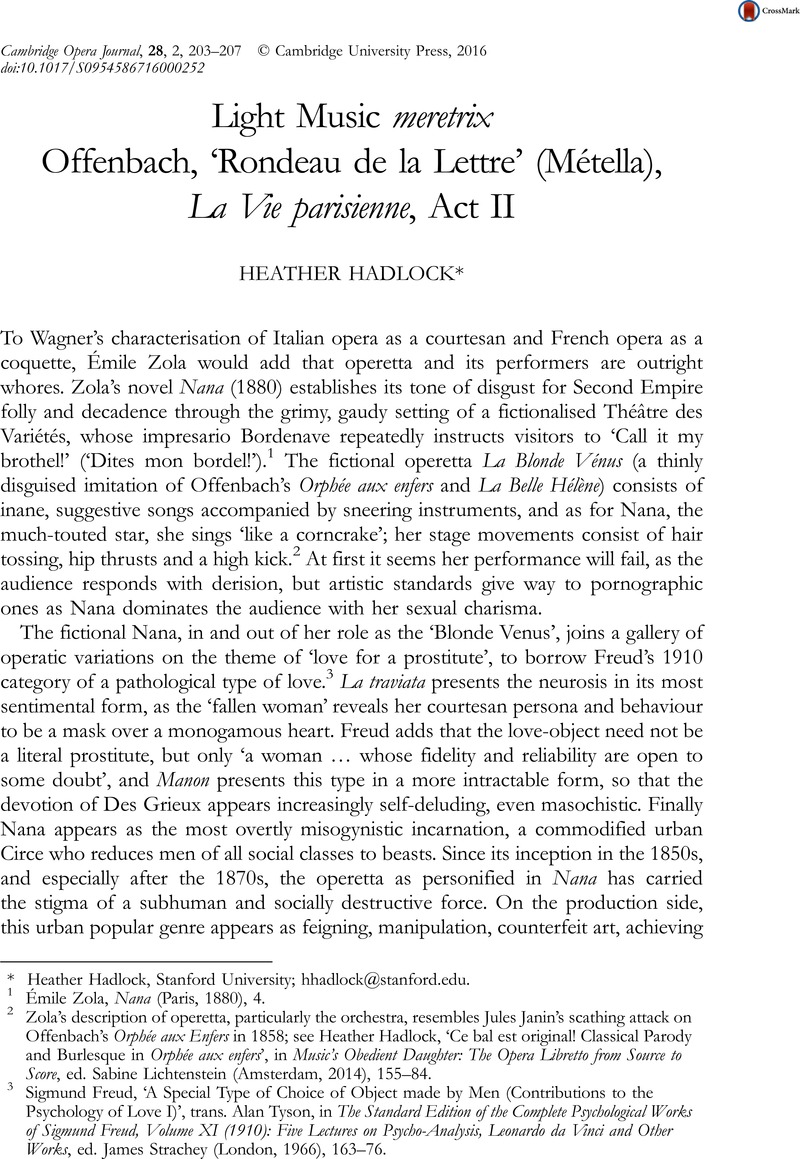No CrossRef data available.
Article contents
Light Music meretrix Offenbach, ‘Rondeau de la Lettre’ (Métella), La Vie parisienne, Act II
Published online by Cambridge University Press: 28 September 2016
Abstract

- Type
- Research Article
- Information
- Cambridge Opera Journal , Volume 28 , Special Issue 2: Special Issue: Remaking the Aria , July 2016 , pp. 203 - 207
- Copyright
- © Cambridge University Press 2016
Footnotes
Heather Hadlock, Stanford University; hhadlock@stanford.edu.
References
1 Zola, Émile, Nana (Paris, 1880), 4 Google Scholar.
2 Zola’s description of operetta, particularly the orchestra, resembles Jules Janin’s scathing attack on Offenbach’s Orphée aux Enfers in 1858; see Hadlock, Heather, ‘Ce bal est original! Classical Parody and Burlesque in Orphée aux enfers ’, in Music’s Obedient Daughter: The Opera Libretto from Source to Score, ed. Sabine Lichtenstein (Amsterdam, 2014), 155–184 Google Scholar.
3 Freud, Sigmund, ‘A Special Type of Choice of Object made by Men (Contributions to the Psychology of Love I)’, trans. Alan Tyson, in The Standard Edition of the Complete Psychological Works of Sigmund Freud, Volume XI (1910): Five Lectures on Psycho-Analysis, Leonardo da Vinci and Other Works, ed. James Strachey (London, 1966), 163–176 Google Scholar.
4 André Messager’s 1898 operetta Véronique also contains a ‘Rondeau de la Lettre’ (sometimes designated ‘Strophes de la Lettre’ or simply ‘Lettre’). In this letter scene, ‘Adieu, je pars’, a young man reads aloud a farewell letter he has received from a girl.
5 The name ‘Metella’ appears in ancient Roman histories as a debauched aristocratic wife. Georges Sand used it for the title character in her 1833 novella Metella: an expatriate English woman living an unconventional life with her lover in Florence. Sand’s novel seems the likeliest source for Meilhac and Halévy who use the name Métella for a courtesan character in two plays, La Clé du Métella (1862) and Le Photographe (1864), prior to their libretto for La Vie parisienne (1866).
6 On this older quality, see Feldman, Martha and Gordon, Bonnie, eds., The Courtesan’s Arts: Cross-Cultural Perspectives (Oxford, 2006)Google Scholar, and in particular Ruggiero, Guido, ‘Who’s Afraid of Giulia Napolitana? Pleasure, Fear, and Imagining the Arts of the Renaissance Courtesan’, 280–293 Google Scholar.
7 Adorno, T. W., ‘On the Social Situation of Music’, in Essays on Music, ed. Richard D. Leppert (Berkeley, 2002)Google Scholar, esp. 427–31.




